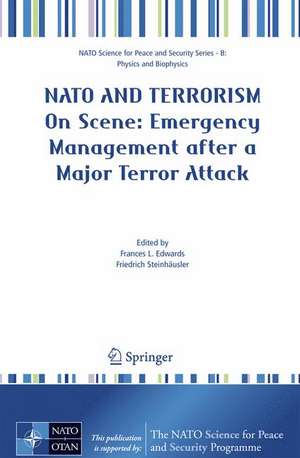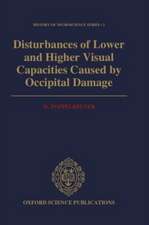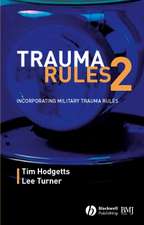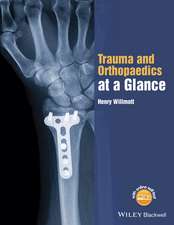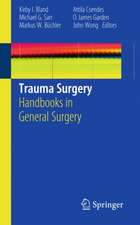NATO And Terrorism: On Scene: New Challenges for First Responders and Civil Protection: NATO Science for Peace and Security Series B: Physics and Biophysics
Editat de Frances L. Edwards, Friedrich Steinhäusleren Limba Engleză Paperback – 29 iun 2007
| Toate formatele și edițiile | Preț | Express |
|---|---|---|
| Paperback (1) | 639.73 lei 6-8 săpt. | |
| SPRINGER NETHERLANDS – 29 iun 2007 | 639.73 lei 6-8 săpt. | |
| Hardback (1) | 646.11 lei 6-8 săpt. | |
| SPRINGER NETHERLANDS – 2 aug 2007 | 646.11 lei 6-8 săpt. |
Din seria NATO Science for Peace and Security Series B: Physics and Biophysics
- 18%
 Preț: 955.25 lei
Preț: 955.25 lei - 18%
 Preț: 1222.62 lei
Preț: 1222.62 lei - 24%
 Preț: 1057.17 lei
Preț: 1057.17 lei - 24%
 Preț: 788.31 lei
Preț: 788.31 lei - 18%
 Preț: 1223.74 lei
Preț: 1223.74 lei - 18%
 Preț: 1830.34 lei
Preț: 1830.34 lei - 15%
 Preț: 643.99 lei
Preț: 643.99 lei - 18%
 Preț: 1212.36 lei
Preț: 1212.36 lei - 18%
 Preț: 947.85 lei
Preț: 947.85 lei - 18%
 Preț: 950.52 lei
Preț: 950.52 lei - 20%
 Preț: 565.64 lei
Preț: 565.64 lei - 18%
 Preț: 950.66 lei
Preț: 950.66 lei - 24%
 Preț: 1060.06 lei
Preț: 1060.06 lei - 5%
 Preț: 1412.06 lei
Preț: 1412.06 lei - 18%
 Preț: 1226.90 lei
Preț: 1226.90 lei - 18%
 Preț: 945.79 lei
Preț: 945.79 lei - 18%
 Preț: 1221.20 lei
Preț: 1221.20 lei - 24%
 Preț: 789.61 lei
Preț: 789.61 lei - 18%
 Preț: 947.67 lei
Preț: 947.67 lei - 24%
 Preț: 1053.41 lei
Preț: 1053.41 lei - 18%
 Preț: 1834.77 lei
Preț: 1834.77 lei - 18%
 Preț: 943.08 lei
Preț: 943.08 lei - 15%
 Preț: 640.06 lei
Preț: 640.06 lei - 18%
 Preț: 945.30 lei
Preț: 945.30 lei - 18%
 Preț: 1217.62 lei
Preț: 1217.62 lei - 18%
 Preț: 951.14 lei
Preț: 951.14 lei - 18%
 Preț: 1216.02 lei
Preț: 1216.02 lei - 18%
 Preț: 1839.17 lei
Preț: 1839.17 lei - 15%
 Preț: 645.47 lei
Preț: 645.47 lei - 18%
 Preț: 1220.57 lei
Preț: 1220.57 lei - 18%
 Preț: 1217.90 lei
Preț: 1217.90 lei - 18%
 Preț: 1228.96 lei
Preț: 1228.96 lei - 18%
 Preț: 1232.71 lei
Preț: 1232.71 lei - 15%
 Preț: 652.17 lei
Preț: 652.17 lei - 18%
 Preț: 1220.88 lei
Preț: 1220.88 lei - 18%
 Preț: 1224.36 lei
Preț: 1224.36 lei - 18%
 Preț: 1828.29 lei
Preț: 1828.29 lei
Preț: 639.73 lei
Preț vechi: 752.63 lei
-15% Nou
Puncte Express: 960
Preț estimativ în valută:
122.41€ • 127.82$ • 101.08£
122.41€ • 127.82$ • 101.08£
Carte tipărită la comandă
Livrare economică 15-29 aprilie
Preluare comenzi: 021 569.72.76
Specificații
ISBN-13: 9781402062766
ISBN-10: 1402062761
Pagini: 261
Ilustrații: XVII, 262 p.
Dimensiuni: 155 x 235 x 22 mm
Greutate: 0.4 kg
Ediția:2007
Editura: SPRINGER NETHERLANDS
Colecția Springer
Seria NATO Science for Peace and Security Series B: Physics and Biophysics
Locul publicării:Dordrecht, Netherlands
ISBN-10: 1402062761
Pagini: 261
Ilustrații: XVII, 262 p.
Dimensiuni: 155 x 235 x 22 mm
Greutate: 0.4 kg
Ediția:2007
Editura: SPRINGER NETHERLANDS
Colecția Springer
Seria NATO Science for Peace and Security Series B: Physics and Biophysics
Locul publicării:Dordrecht, Netherlands
Public țintă
ResearchCuprins
Foreword. Preface. Acknowledgements. Contributors. Introduction. Overview. The issue. Emergency planning and terrorism. The framework. Security threat assessment. Preparing for natural hazards vs. terror attack: a matter of risk. The new risk environment. Unconventional use of conventional explosives. Radiological weapons. Weapons of mass destruction. Emergency management challenges. Challenges to law enforcement due to a major terror attack. Challenges due to NRBC threats. Covert versus overt terror attack. Response by law enforcement agents. Prevention and disruption by law enforcement agents. General indicators of CBRNE terrorist activities. Legal aspects of emergency situations. The importance of legal measures during pre- and post-attack periods. Terrorism versus catastrophic terrorism. Criminal justices responses. Tort law as a societal mechanism to protect the innocent injured. Tort lawsuits in a post-9/11 world. Breaking the mold. Distributive justice model and its limitations. Not unusual policy. Fund replacement of tort action for victims of WMVs. Policy correction needed. Legal issues for emergency management planning. Protection against terrorism through emergency management structures. Structures for managing alerting and warning. Public Alerting and Warning. Public Warning Technical Systems. Post Event Messages.Role of Government versus Responsibility of Individual. Emergency Management Structures for Managing Response. Local, State and Federal Structures. Evacuation or Shelter in Place. Federal Structures for Rendering Aid. Non-Governmental Organizations’ Role. Using Technology to Aid Planning and Response. Air Modeling. Land Use-Based Modeling. Structural Engineering as Mitigation. Cross Border Interoperability Across Systems. Communications Systems. Interoperable Equipment. Coordination/Command and Control Systems. Receiving External Help – Existing Systems. Special Challenges for Cross-Border Law Enforcement. International disaster response.United Kingdom National Overview. Overview of UK Preparedness. Training and Exercises. Case Study: London Bombings July 2005. National emergency preparedness in the Netherlands: Uncertainty in doing the right things. Change In Risk Awareness. The Dutch Crisis Control Organization. A Scientific Approach to Emergency Management. German Civil Protection. Federal Risk Assessment and Central Emeregency response. The Level of Capacity of First Responders. Protection Against Terrorism through Emergency Management Structures in Norway. Justification and Rationale for Emergency Preparedness. Norwegian Emergency Preparedness – Principles and Priorities. Norwegian Legislation and Regulations on Emergency Preparedness. Structural Framework. First Responder Community in Norway. Danish Emergency Preparedness. Principles and Priorities. Danish Legislation and Regulations on Emergency Preparedness. Structural Framework. First Responders in Denmark. Norwegian and Danish Emergency Preparedness Compared. Emergency Preparedness in Portugal. The U.S. Response to Catastrophic Urban Disasters. Preparatory Phase. Command and Control. Phases of Response. Search Concept of Operations. The Role of Specialists. Special Search Operations. Conclusion. National Emergency preparedness in case of terrorism in Russia. EMERCOM Organization.Operational Plans within EMERCOM. Management Actions. Action Plan. The Beslan School Terror Attack. Response to Unconventional Terrorist Attacks in Israel. Homefront Command. Terrorism Response Planning and Training. Phased response to a terror attack. NATO and consequence management: The Euro-Atlantic Disaster Response Coordination Centre. Introduction. The Role of NATO and EADRCC. The International staff: Ops Division organization. Steps taken after a request for assistance.I nventory of national chemical, biological and radiological capabilities. Examples of NATO response capabilities. Training and Exercises. NATO SHAPE/Allied Command Operations. EuropeanUnion Civil Protection Mechanism. Maintaining preparedness. Lessons learned. Organization for the prevention of chemical weapons. Roles and expertise. Intervention capabilities. The Way Forward. Research and development needs in field response to terrorism. Introduction. The catastrophic risk model as a basis for R&D on emergency management. R&D into Urban Warfare and Terrorist Capability. Strategic operations model for scientific innovation. Timelines for deliverables. Short-term challenges for R&D. Mid-term challenges for R&D. Long-term challenges for R&D. Conclusions and recommendations.International challenges in cooperation against terrorism.Conclusions of the workshop. Research and improvement program for NATO member states. Security Threat Assessment. Protection against terrorism through emergency management structures. Research and development needs in field response to terrorism. International disaster response. Managing a radiological attack. Conclusions and next steps. Appendix 1: List of Participants.Appendix 2: Fourth Generation Warfare. Appendix 3: Review of the Brazilian Emergency Management After The Radiological Incident in Goiania in 1987. Appendix 4: Review of the US Emergency Management After the Terror Attacks in New York City on September 11, 2001. Appendix 5: Review of the US Emergency Management After the Hurricane "Katrina," August 29 – September 1, 2005. References. Acronyms. Index.
Caracteristici
Provides a comprehensive review of the challenges posed to first responders and emergency managers by terrorism Provides a unique approach to coordinating preparedness and response to terrorism attacks against cities and infrastructure across boundaries Provides a unique set of non-traditional tools and strategies for enhancing response to WMD, WMK, and WMDi-terrorist attacks Provides a unique approach to training and exercising to being prepared for terrorism response Provides insight into fourth generation warfare and its challenge to first responders
